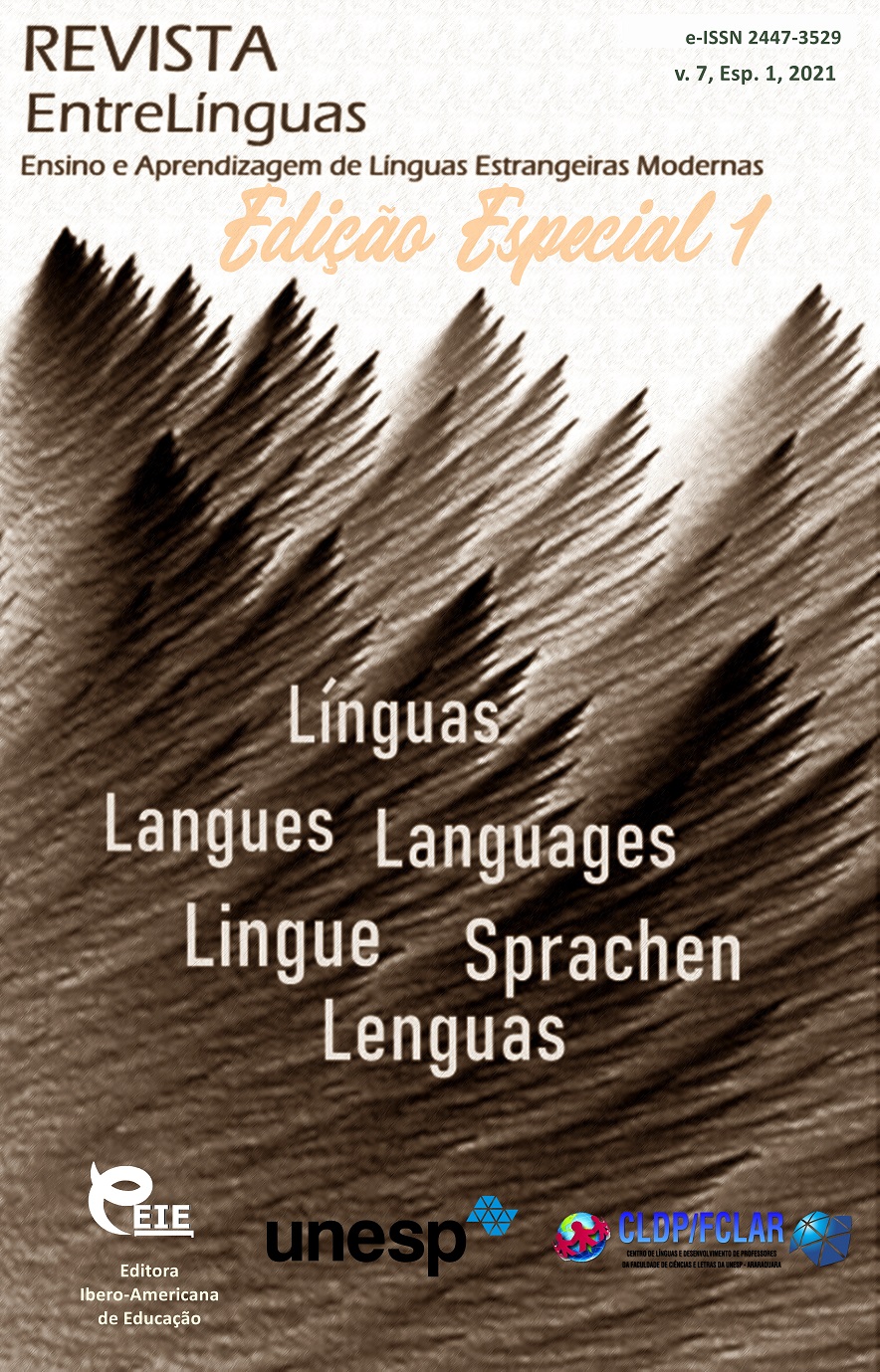Policode: texto creolizado como meio de manipulação
DOI:
https://doi.org/10.29051/el.v7iEsp1.14892Palabras clave:
Multicódigo, Texto creolizado, Manipulación, Tácticas transformadoras, Tácticas de apoyo, Tácticas de distracciónResumen
Una forma de influir es criollizar un texto. En el estudio actual, se intentó discutir el potencial manipulador de los textos criollos. Agregar una ilustración a un texto verbal puede visualizar información y tener un impacto planificado en el destinatario que no sea el impacto del texto verbal, es decir, se modifica el contenido del texto verbal. Se identificaron tres grupos de tácticas durante el estudio: 1) tácticas de apoyo (el contenido del texto recibe apoyo de la ilustración); 2) tácticas de transformación (transformación del contenido del texto); 3) tácticas de distracción (distracción del destinatario del contenido del texto verbal). Utilizando las tácticas del primer grupo, se puede "decir" lo mismo mediante una ilustración; usando las tácticas del segundo grupo; se puede agregar algo, cambiar el contenido del texto verbal y, utilizando las tácticas del tercer grupo, se puede distraer a los destinatarios del contenido del texto verbal.
Descargas
Citas
ACHWAN, R.; GANIE-ROCHMAN, M.; ALAMSYAH, A. R.; TRIANA, L. University reform and the development of social sciences in Indonesia. International Journal of Educational Development, v. 7, n. 8, p. 102269, 2020.
AIMOLDINA, A.; ZHARKYNBEKOVA, S. Incorporating authentic models into business letter writing within the ESP course at Kazakhstani universities. Hacettepe University Journal of Education, v. 29, n. 29-2, p. 16-33, 2014.
ANISIMOVA, E. E. Linguistics and intercultural communication (based on creolized texts): Textbook for the students of foreign languages universities. Moscow/ Russia: Publishing Center Academy. (2003).
BENDER, E. M.; LASCARIDES, A. Linguistic fundamentals for natural language processing ii: 100 essentials from semantics and pragmatics. Synthesis Lectures on Human Language Technologies,v. 12, n. 3, p. 1-268, p. 2019.
CHERNJAVSKAJA, V. Linguistics of the text. polycode, intertextuality, interdiscursiveness. Institute of Linguistics RAS, v. 1, n. 2, p. 5-21, 2009.
FARZADNIA, S.; GILES, H. Patient-provider interaction: A communication accommodation theory perspective. International Journal of Society, Culture & Language, v. 3, n. 2, p. 17-34, 2015.
KEATON, S. A.; GILES, H. Subjective health: The roles of communication, language, aging, stereotypes, and culture. International Journal of Society, Culture & Language, v. 4, n. 2, p. 1-10, 2016.
LEEWEN, E. Sternes “Journal to Eliza”: A semiological and linguistic approach to the text. Tübingen/ Germany: Gunter Narr Verlag, 1981.
LIANG, M. Y. Achieving multimodal cohesion during intercultural conversations. International Journal of Society, Culture & Language, v. 4, n. 2, p. 55-70, 2016.
MARDIEVA, L. Pre-existing visual images and phenomena: A linguistic approach. SGEM, v. 1, n. 3, p. 765-772, 2016.
MERZLYAKOV, D.; IGNATOVA, E. Understanding creolized text in the system “author-reader” on the example of texts with graphic and realistic images. In: INTERNATIONAL CONFERENCE ON PEDAGOGY, COMMUNICATION AND SOCIOLOGY, 2019, Ningbo. Proceedings […]. Ningbo, China: ICPCS, 2019.
MOUSAVI, S. A.; FARAHANI, A. A.; ARIZAVI, S. An investigation of the linguistic, paralinguistic and sociocultural effects of input on the perception and translation of gerunds by Persian speakers of English. International Journal of Society, Culture & Language, v. 2, n. 1, p. 119-130, 2014.
MUKHAMETZYANOVA, L.; MARDIEVA, L. The polyfunctuanality in the names of newspapers and magazines. Revista San Gregorio, v. 20, n. 1, p. 148-153, 2017.
NASYROVA, A.; KHABUTDINOV, A.; KHABUTDINOVA, M. Magazine illustration as epoch investigation source (Aisilu (1959) by BaqiUrmanche as an example). Turkish online journal of design art and communication, v. 2, n. 6, p. 3094-3099, 2016.
NOVIKOV, A. I. Semantics of the text and its formalization. Moscow/ Russia: Nauka Publisher, 1983.
RIEDEL, I. Colors in religion, society, art and psychotherapy. Stuttgart/ Germany: Kreuz Publisher, 1999.
RYABOVA, M. Foreign language as a factor of personality development: methodology for the development of a socio-philosophical concept, Saransk/ Russia: Mordovia University Publishing Houses, 2007.
SHKURKO, V.; MARDIEVA, L.; SHCHUKLINA, T.; CHUDINOV, A. Poster images in a new linguistic and extralinguistic context. Amazonia Investigation, v. 7, n. 12, p. 320-324, 2018.
SONIN, A. Understanding polycode texts: the cognitive aspect. Institute of Linguistics RAS, v. 5, n. 2, p. 9-19, 2005.
ULANOVSKY, A. False metaphors of happiness. Institute of Linguistics RAS, v. 13, n. 4, p. 10-19, 2019.
VASHUNINA, I. V.; RYABOVA, M. E.; EGOROVA, L. A. Polycode hypertext in polylingual discourse of intercultural communications. Xlinguae, v. 7, n. 4, p. 25-36, 2018.
VERBOON, P.; VAN DIJKE, M. The effect of perceived deterrence on compliance with authorities: the moderating influence of procedural justice. International Journal of Criminology and Sociology, v. 1, n. 5, p. 151-161, 2012.
VOISHVILLO, E. K. The concept as a form of thinking: logical and epistemological analysis. Moscow/ Russia: Moscow State University, 1989.
WILDGEN, W.; SEMIOTIK, V. The development of the visible: from the cave picture to the modern city. Bielefeld/ Germany: Transcript-Verlag, 2013.
Descargas
Publicado
Cómo citar
Número
Sección
Licencia

Esta obra está bajo una licencia internacional Creative Commons Atribución-NoComercial-CompartirIgual 4.0.
Os manuscritos aceitos e publicados são de propriedade da Revista EntreLínguas. Os artigos publicados e as referências citadas na Revista EntreLínguas são de inteira responsabilidade de seus autores.
Transferência de direitos autorais – autorização para publicação
Caso o artigo submetido seja aprovado para publicação, já fica acordado que o(s) autor(es) autoriza(m) a UNESP a reproduzi-lo e publicá-lo na EntreLínguas, entendendo-se os termos “reprodução” e “publicação” conforme definição respectivamente dos incisos VI e I do artigo 5° da Lei 9610/98. O artigo poderá ser acessado pela rede mundial de computadores (Internet), sendo permitidas, a título gratuito, a consulta e a reprodução de exemplar do artigo para uso próprio de quem a consulta, desde que haja a citação ao texto consultado. Essa autorização de publicação 328 EntreLínguas, Araraquara, v. 1, n .2, p. 323-328, jul./dez. 2015 não tem limitação de tempo, ficando a UNESP responsável pela manutenção da identificação do(s) autor(es) do artigo. Os artigos publicados e as referências citadas na Revista EntreLínguas são de inteira responsabilidade de seus autores.











